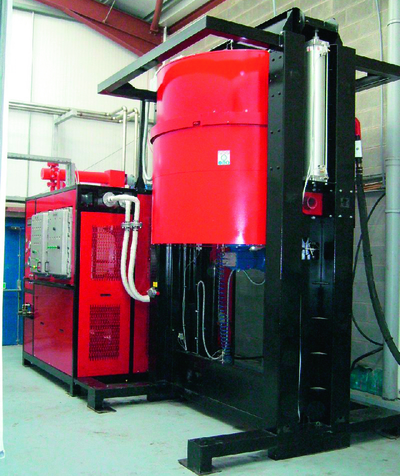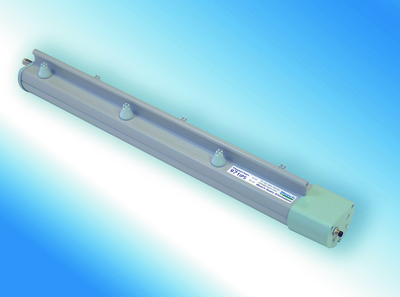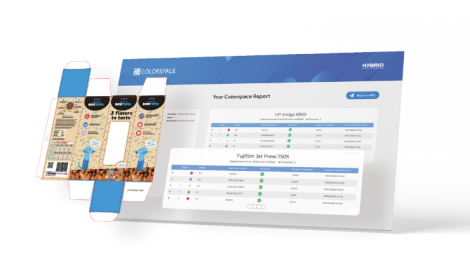The Hyperion 971IPS static elimination bar with integrated power supply from Meech
Although they can make a huge impact on print quality and cost reduction, static electricity and solvent recovery are just two of the many ancillary processes that receive little or no attention. Neel Madsen tries to put this right.
There is more to the flexographic printing process than simply getting the right colour onto the substrate in the right place. A large number of ancillary processes and products are involved in running a flexo press and achieving best results. These may seem minor but issues, such as static control, can cause major problems, while solvent recovery can save on cost and reduce the environmental impact of the chemicals used in inks and coatings.
Controlling the static
The build up of static electricity during the printing process can cause many issues. It most commonly occurs during contact and separation of non-conductive materials, such as unwinding filmic substrates from a roll or separating synthetic sheets. This build up can be compounded by passing the materials at high speed over rollers. Rapid heat change can also generate static electricity.
The effects of static electricity on a synthetic substrate can cause unpredictable outcomes, including dust attraction (picking up dust particles from several feet away), print defects, uneven winding and possibly shocks to operators, all of which result in downtime and loss of revenue. Another issue to take into account is that high static charges can also cause problems with ink adhesion, as they can actually repel the ink from the material surface and affect the overall quality of the finished product. Not only does this scenario lead to increased production costs, it can also lead to reduced production speeds.
All of these situations are well known and all are avoidable. There are a number of products on the market designed to eliminate static.
Master of the bar
‘Meech has long recognised the issues caused by the phenomenon of static charges, which is why we aim to provide customers with the excellent standards of static elimination they have come to expect from our brand. In that spirit our most recent bars, the 971IPS and 929IPS, were developed as a response to customer feedback,’ said David Rogers, business unit director static control.
The Hyperion 971IPS static elimination bar with integrated power supply allows users to run the long range ionising bar from a 24V power supply and borrows some of its features from Meech’s first true closed-loop Pulsed DC static control system, the 977CM, although in miniature form. For instance, Ion Current Monitoring technology allows the performance of the bar to be metered and also provides an alarm signal to advise the operator to clean the bar.
For more demanding installations, the company has developed a remote programmer, the Hyperion BarMaster, which when connected to the 971IPS enables the engineer to adjust the balance and frequency of the outputs, as well as setting the alarm parameters. Once the output has been optimised and the alarm levels selected, the BarMaster can be removed and used to program the next bar.
The 929IPS is a 24V, plug and play bar, which provides ionisation for short to medium range applications (up to 500 mm). Like the long range 971IPS, the 929IPS features Ion Current Monitoring technology to provide performance alarms and cleaning alerts.
Compatibility with the BarMaster allows the engineer to modify the output settings, depending on their requirements. This adjustability will be of great benefit to high accuracy applications, such as RFID converting machinery, according to Mr Rogers.
‘The 929IPS is not only the most advanced of Meech’s new bars, it is also IP66 rated, which means it can be used in environments where the productions lines may be washed down, such as food packaging applications,’ he concluded.

This industrial strength solvent recovery system from Solutex is a 600 litre capacity unit
On the range
Devon-based Fraser Anti-Static Techniques Ltd said it continues to invest significant resources into the research and development of industrial static control solutions. Its range of static eliminators includes the 3024 Ionising Bar, which is ideal for unwind and rewind applications.
The bar is available in two versions: the high speed 3024 F for speeds up to 1000 m/min, for distances from 25 mm to 150 mm, and the 3024 L long range version
for distances from 100 mm to 500 mm, which has been installed on over 200 film winders of all types. When positioned as far as 500mm from a winder, the 3024 L can achieve complete neutralisation of the reel without any air assistance.
The bars feature LED status indication for fault detection and the integrated high voltage power supply requires only a low voltage 24V DC input. Using 24V DC supply through the slip ring can also provide a solution to the difficult problem of turret rewinders.
Davin Broadbent, marketing manager, said, ‘The 3024 is the only bar of its type to have international approvals from UL (the global independent safety science company), and the CB international product passport from the IEC. This has allowed it to make full use of its 24V supply and be independent of local voltages.’
For work at closer ranges, Fraser has developed the 1250 Series. Resistively coupled to facilitate neutralising high charges at fast speeds, the 1250 Static Eliminator range is described as ‘the perfect partner for modern high productivity machinery in the plastics, printing and converting industries’. The range is also available as an ATEX certified bar for use in hazardous areas (the ATEX Directive 94/9/EC deals with equipment and protective systems intended for use in potentially explosive atmospheres).
Easy manager
Established in 1946, Simco-Ion Europe is a part of the ITW Group. It has a comprehensive range of products to control static electricity for the plastics, packaging, converting and printing industries.
The company has introduced the new IQ Easy platform, which controls all devices in a static elimination system through the Manager IQ Easy module. Independent of their function, whether it is an anti-static bar, charging generator, perforation detector or measuring device, the devices can all communicate with the Manager function. This comprises a control unit with a 7 inch LCD touch screen, provides information from all the connected devices and makes it easy to change and monitor status and parameters. Up to six IQ devices can be directly connected to the Manager although with the Extension IQ Easy functionality, a further six devices can be added to the system (with a maximum of 30). The 24V DC power distribution is also routed via the Manager, eliminating the need for extra cables.
Through Simco-Ion’s patented technology of upstream charge evaluation, neutralisation of static can be fine-tuned in combination with a Performax IQ Easy anti-static bar. Adding a Sensor IQ Easy to the system will allow the user to measure the downstream charge on the material. The system can also be perfected further to enhance efficiency and allow quality control. Closed loop measuring and adjustment of the static bar output will guarantee a residual charge of less than 1 kilo-volts at 1000 m/min speeds.
Solvent recovery
In many cases, flexographic printing presses are equipped with an automatic cleaning system. During each press cleaning cycle, a certain amount of clean solvent is used. More solvent is used depending on the number of colour changes and different printing jobs. Solvents are also used in the platemaking process and these become contaminated with waste polymers. When the cost of new solvents and waste disposal are taken into consideration, solvent recycling becomes a genuine cost effective alternative.
Shropshire-based Solutex Ltd supplies solvent recycling systems for use with new or existing flexographic printing presses and platemaking operations. It has a wide range of systems that are suitable for small and large users.
For high volume users, Solutex offer fully automatic systems combined with solvent storage tanks that can be integrated into new or existing systems to provide a fully automatic cleaning cycle. One of the major features is the rotating boiler that provides easy cleaning and maintenance at floor level.
In contact
One company that has seen the benefits of this technology is Contact Orginators Ltd. Originally formed in 1992 to service the litho pre-press market, Contact expanded rapidly into the flexographic sector. It is one of the largest privately owned companies within the UK pre-press sector and has 78 staff throughout the UK.
Contact has recently made a large investment in new platemaking equipment with HD Flexo and flat-top dot technology. Together with the development of alternative and more environmentally friendly solvents in the platemaking process, the company decided to make the switch to one of these new solvents as part of its development plans. This was complemented by a DvQ600WxPCU, 600 litre capacity unit from Solutex.
Nick Mitchell from Contact Originators explained, ‘Many platemakers will invest in the state of the art front end equipment but neglect a hugely important area of the process in the distillation recovery and balancing of the solvent. You wouldn’t put a Ford Fiesta engine in a Ferrari so why do the same in theory with your platemaking process? Solvent is vital to producing a good quality flexo plate efficiently, especially with the advancement of high definition flexo and flat-top dot technology in our sector. If your solvent is not balanced, this will have a direct affect on your plate quality and your customers print.
‘We looked long and hard at the various units the market had to offer and something that would fit into our current workflow, the Solutex unit ticked all the boxes. The project management and installation of the unit was first class, as is the ongoing technical support and servicing. This system has enabled us to run less distillation cycles, increasing yield, capacity and quality whilst also reducing labour time through its self clean mechanism.’






